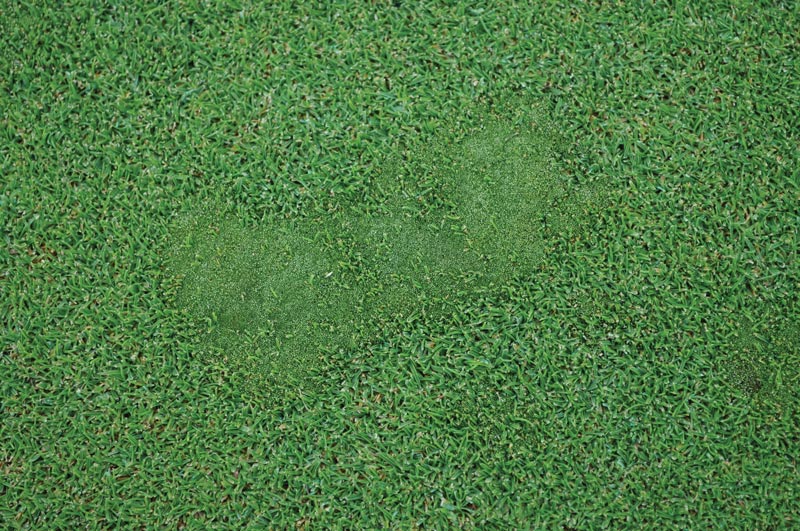
Silvery-thread moss outcompeted creeping bentgrass in a research putting green in Manhattan, Kan. Photos by Zane Raudenbush
Controlling silvery-thread moss (Bryum argenteum Hedw.) infestations in putting greens can be difficult because of the moss’s unique morphological and biological properties. Silvery-thread moss is a perennial species capable of tolerating a wide range of environmental conditions, and it is highly competitive during low temperatures (2, 5), when the relative growth rate of desirable cool-season turfgrass species is low. A silvery-thread moss infestation typically begins as small colonies (< 2 inches [5 cm] in diameter), but infestations can rapidly increase in size if environmental conditions are conducive to silvery-thread moss growth and dispersal.
Dispersal and growth
Silvery-thread moss can invade new habitats via production of sexual and asexual structures, but once established, it is believed to spread exclusively through asexual structures (11, 13). Two common modes of asexual reproduction are fragmentation and bulbil production (3, 13). Fragmentation is the physical movement of an existing silvery-thread moss shoot. Bulbils are highly condensed leaf primordia and are actively produced by an existing silvery-thread moss shoot. Shoot fragments and bulbils are important mechanisms of dispersal because both are readily transported by machinery and water. Left unchecked, a small infestation can quickly spread throughout a putting green via these asexual structures, which makes taking action early in an infestation imperative.
Standard golf course management practices often affect the population dynamics of silvery-thread moss in a creeping bentgrass putting green. For example, mowing at 0.125 inch (3.2 mm) resulted in a 1.6-fold increase in silvery-thread moss severity over mowing at 0.157 inch (4.0 mm) (4). After investigating different nitrogen sources, researchers discovered that soluble nitrogen sources increased silvery-thread moss severity in greens (10, 16). Irrigation practices may also influence silvery-thread moss invasion. Silvery-thread moss establishment was found to increase with higher irrigation frequencies in greenhouse experiments (6), but several light topdressing applications were shown to reduce silvery-thread moss severity slightly (1). Finally, applications of the herbicide carfentrazone (QuickSilver, FMC Corp.) can selectively suppress silvery-thread moss in creeping bentgrass (1, 4, 15). Different combinations and intensities of these practices are likely to affect the success of silvery-thread moss control measures.
Cultivation practices
Little is known, however, about the effect of turfgrass cultivation on silvery-thread moss severity in putting greens. Aerification and vertislicing are commonly used to manage thatch and compaction and to increase water infiltration. Both practices create temporary openings in the turfgrass canopy, which may be recolonized by either silvery-thread moss or creeping bentgrass, but it is unclear which species will ultimately occupy the available sites.
Personal observations indicate creeping bentgrass has a difficult time recolonizing an area currently occupied by silvery-thread moss, because stolons and tillers cannot penetrate the dense gametophyte. Aerification and vertislicing can create available sites within the moss gametophyte, which would allow neighboring creeping bentgrass plants to establish. Conversely, silvery-thread moss propagules may reside in the available sites and further the infestation. Unfortunately, no published research has evaluated the effect of aerification or vertislicing on an existing silvery-thread moss infestation.
When used in conjunction with aerification or vertislicing, applications of sand topdressing might give creeping bentgrass a competitive advantage in colonizing available sites by suppressing silvery-thread moss growth (1). Similarly, applications of carfentrazone have been shown to be highly effective at suppressing silvery-thread moss growth (1, 4, 15), and thus may also be a valuable tool for shifting the population dynamics in favor of creeping bentgrass when aerification and/or vertislicing are implemented.
The objective of our study was to determine the effect of cultivation — with and without light, frequent topdressing and carfentrazone — on an existing silvery-thread moss infestation in a creeping bentgrass putting green. We hypothesized that cultivation would reduce silvery-thread moss cover when used in conjunction with carfentrazone or topdressing, but would increase silvery-thread moss cover when implemented as a stand-alone practice.
Materials and methods
A two-year field experiment was conducted from October 2012 to October 2014 at the Rocky Ford Turfgrass Research Center in Manhattan, Kan. Treatments were applied to a Penncross creeping bentgrass putting green with an existing silvery-thread moss infestation. The green had a sand-based root zone with a soil pH of 8.0.
The area was walk-mowed six days per week from March to November using a Toro Greensmaster Flex 21 (The Toro Co.) at a bench cutting height of 0.118 inch (3.0 mm). Irrigation was hand-applied to ensure even distribution and was typically applied every one to two days from May to September as needed to prevent creeping bentgrass wilt.
Plots were fertilized from April to October and received a total of 3.5 pounds nitrogen/1,000 square feet (170.9 kilograms/hectare). An 18-9-18 granular fertilizer (Contec DG, The Andersons) was applied at 0.75 pound nitrogen/1,000 square feet (36.6 kilograms/hectare) in spring and fall when cultivation treatments were administered. Additionally, foliar applications of urea (UFlexx, Koch Agronomic Services [0.2 pound nitrogen/1,000 square feet; 9.8 kilograms/hectare]) and liquid 0-2-2 (Emerald Isle PanaSea Plus, LebanonTurf [0.004 pound potassium/1,000 square feet; 0.195 kilogram/hectare]) were applied every two weeks from May to September.
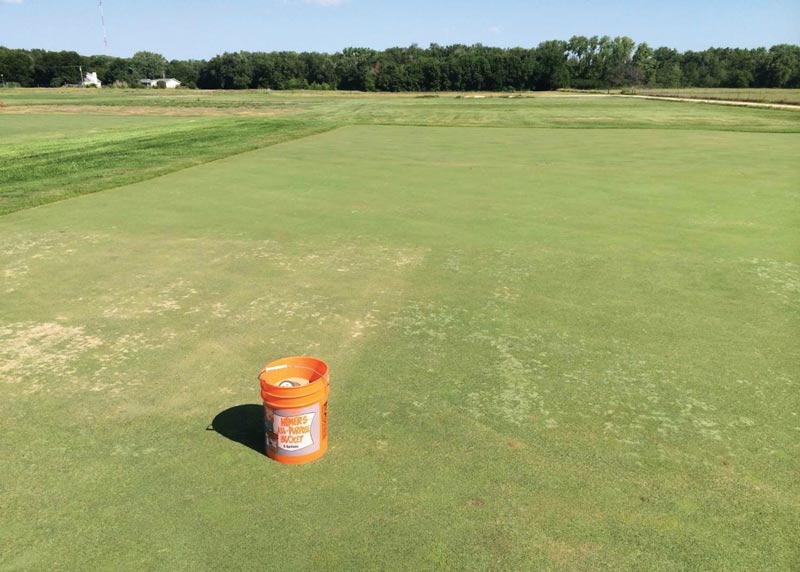
The plots on the left were treated with frequent topdressing, and those on the right received infrequent topdressing treatments. Topdressing was thought to suppress growth of silvery-thread moss and give creeping bentgrass an advantage in colonizing available sites.
A randomized complete block design using three blocks and a split-plot treatment structure was used to evaluate the effects of three main treatments: topdressing (two levels), herbicide (two levels) and cultivation (four levels). Treatments were applied to the same plots in both study years to evaluate the cumulative effect over time on silvery-thread moss cover.
Whole plots measured 12 feet (3.65 meters) × 12 feet and received either infrequent or frequent topdressing applications. The infrequent topdressing treatment consisted of 4.28 cubic yards/acre (8 cubic meters/hectare) of sand applied directly after cultivation treatments, and the frequent treatment consisted of 4.28 yards/acre of sand applied directly after cultivation treatments + 2.14 yards/acre (4 cubic meters/hectare) of sand applied every two weeks from May to September in 2013 and 2014. Sand was applied using a handheld shaker jar. The 3-foot-by-4-foot (0.9-meter-by-1.2-meter) subplots contained four cultivation treatments treated with or without herbicide.
Cultivation treatments were applied in the fall and spring of each study year on Oct. 1, 2012; March 29, 2013; Oct. 8, 2013; and April 7, 2014. The four cultivation treatments were: 1) 0.5-inch- (1.27 cm-) diameter hollow-tine aerification at low intensity (3.9% surface disruption); 2) 0.5-inch-diameter hollow-tine aerification at high intensity (7.2% surface disruption); 3) vertislicing; and 4) no cultivation. Aerification treatments were applied using a Toro ProCore 648 operating at 3,000 rpm. The low-intensity surface disruption treatments were achieved by removing half of the 0.5-inch tines from the tine holders.
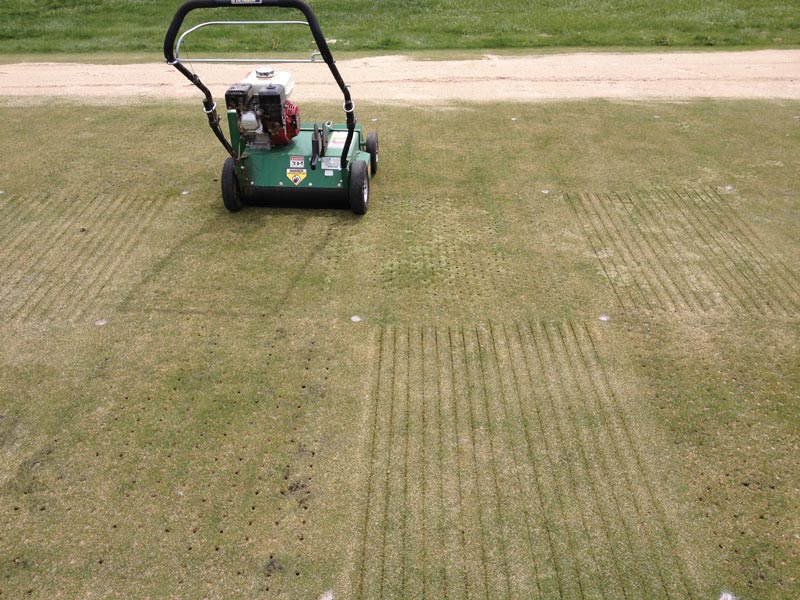
The authors hypothesized that cultivation in the form of hollow-tine aerification or vertislicing (both shown here) along with applications of a herbicide or topdressing would increase the ability of creeping bentgrass to recolonize clumps of silvery-thread moss.
Ejected cores were removed with a shovel, and dry sand was hand-broomed into applicable plots until holes were completely filled. Vertislice treatments were applied using a Billy Goat Power Rake that cut 0.05-inch- (0.127-cm-) wide slits on 2-inch (5-cm) centers at a depth of 0.3 inch (0.76 cm) in the turfgrass surface.
The herbicide treatments were: 1) carfentrazone applied at 0.1 pound a.i./acre (0.11 kilogram/hectare; equivalent to 6.7 fluid ounces QuickSilver/acre) at one week before and one week after cultivation treatments (that is, four applications per year); and 2) no herbicide. Herbicide applications were made using a two-nozzle CO2-powered backpack sprayer equipped with TeeJet XR8002VS nozzles and calibrated to deliver a spray volume of 40 gallons/acre (374 liters/hectare). All herbicide applications included a nonionic surfactant applied at a 0.25% v/v.
Silvery-thread moss is poikilohydric (that is, it has no mechanism to prevent desiccation) and has the potential to be in a dormant state if extracellular water is not present. Therefore, 0.1 inch (0.254 cm) of irrigation was applied the night before carfentrazone applications were made to ensure the silvery-thread moss would be actively photosynthesizing.
Percent moss cover was obtained using a 3-by-4-foot rating grid containing 330 intersections on 2-by-2-inch centers. An application of carfentrazone causes rapid necrosis of the gametophyte tissue; however, the gametophyte carcass does not break down, and regrowth occurs several weeks later (personal observations). Therefore, a positive grid count was recorded if a silvery-thread moss gametophyte was situated directly under an intersection, regardless of whether it was green and healthy, or black/brown and desiccated.
Initial moss cover was determined for each plot on Sept. 24, 2012, one week before any treatments were applied. Subsequent ratings were recorded on March 21, 2013; Oct. 1, 2013; April 1, 2014; and Oct. 1, 2014. Moss cover in individual plots ranged from 20% to 60% at study initiation; therefore, percent change in moss cover at subsequent rating dates was determined by comparing moss cover in each plot with its initial value. Negative values indicate moss cover decreased.
Results and discussion
Several treatments were effective at reducing silvery-thread moss cover over the course of the two-year field study, though no treatment combination completely eradicated silvery-thread moss. Originally, we hypothesized that cultivation would only reduce moss cover when applied in conjunction with the herbicide. However, both treatments — with cultivation alone and herbicide alone — reduced moss cover.
Cultivation
Aerification and vertislicing are golf course management practices that create open spaces, or voids, in the turfgrass canopy. It was unknown whether these voids would be colonized by silvery-thread moss or creeping bentgrass. Our hypothesis that cultivation would only decrease silvery-thread moss cover when combined with herbicide use or topdressing turned out to be incorrect. Both vertislicing and 3.9% surface disruption aerification reduced silvery-thread moss cover compared with the untreated control by the end of the study (Figure 1).
Established silvery-thread moss colonies produce a dense mat of shoots and rhizoids that deter recolonization from creeping bentgrass stolons (personal observation); however, cultivation temporarily introduces available sites within the silvery-thread moss gametophyte. At the conclusion of year one, many of the available sites created by cultivation treatments were occupied by creeping bentgrass, but the effect of cultivation was not significant until the second year, after the treatments had been administered three times.
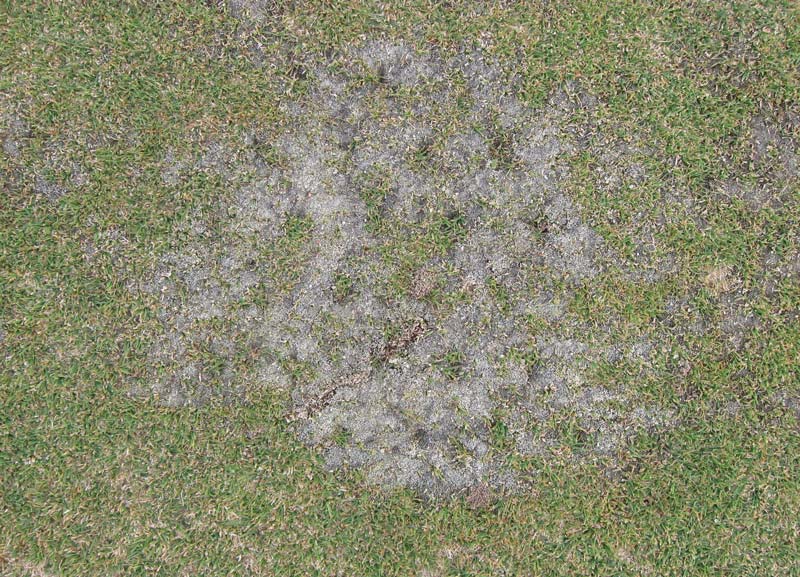
Hollow-tine aerification introduces temporary holes that may permit the introduction of creeping bentgrass into a silvery-thread moss colony, as seen here.
Although the 3.9% surface disruption aerification and vertislicing treatments reduced silvery-thread moss cover by the spring and fall of 2014 compared with the untreated plots, the 7.2% surface disruption aerification treatment resulted in slightly less silvery-thread moss cover, but was not different from the untreated plots. Currently, it is unclear why the 7.2% surface disruption treatment was not as effective as other cultivation treatments. Further research is needed to determine whether an optimal percentage of surface disruption exists for silvery-thread moss control.
Herbicide
Carfentrazone-ethyl reduced silvery-thread moss cover at every rating date throughout the study. Averaged across cultivation and topdressing treatments, a 20% reduction in silvery-thread moss cover was observed after two applications of carfentrazone at a rate of 0.1 pound a.i./acre (Figure 2). Others have reported a 39% reduction (4) and a 36% reduction (1) in silvery-thread moss severity.
No negative effects on bentgrass color or quality were observed following the split applications of carfentrazone. However, the herbicide — a protoporphyrinogen oxidase inhibitor (14) — caused rapid necrosis in the gametophore tips by two to three days after treatment. A total of eight applications of carfentrazone were applied throughout the duration of the study, but on average, only an 80% reduction in moss severity was observed.
Bryophytes such as silvery-thread moss have been reported to have a slower decomposition rate compared with vascular plants. Carfentrazone is very effective at injuring silvery-thread moss, but the necrotic gametophyte is able to resist decay, and regrowth often occurs directly from the injured shoots in the weeks following the initial application (8).
Interestingly, carfentrazone is strictly labeled for post-emergent control of silvery-thread moss in putting greens, but pre-emergent control of silvery-thread moss bulbils and spores plated in carfentrazone-enhanced agar medium has been reported (7). Pre-emergent control of silvery-thread moss propagules would allow superintendents to make an application before implementing practices that aid in dispersal of bulbils and shoot fragments (for example, brushing, verticutting, grooming). Carfentrazone does not persist in the soil because of rapid microbial degradation (14), however, so pre-emergent applications in putting greens may not provide consistent silvery-thread moss control.
Timing often has a dramatic effect on the efficacy of herbicide applications (9, 12). In this study, the split applications of carfentrazone were strategically made one week before and one week after cultivation treatments were administered. Our intention was that the first of the split applications would injure the silvery-thread moss gametophyte, allowing creeping bentgrass to fill the voids created by the cultivation treatments, while the second application (two weeks later) would control any dispersed plant material.
This research supports previous findings showing that carfentrazone is a valuable tool that can temporarily shift stand dynamics in favor of the desirable turfgrass species. However, it is not likely to eradicate silvery-thread moss completely.
Topdressing
Theoretically, topdressing in conjunction with cultivation would shift stand dynamics in favor of creeping bentgrass by partially covering silvery-thread moss (1) and thereby reducing its photosynthetic capacity. However, in our study, light, frequent topdressing did not affect silvery-thread moss cover at any rating date throughout the experiment. These results differ from earlier research (1) that reported a 39% reduction in silvery-thread moss cover from four applications of sand topdressing. The whole plots receiving frequent topdressing did have enhanced turfgrass color and quality (data not shown).
Conclusions
Superintendents confronted with silvery-thread moss infestations should use a multifaceted approach with two main goals: reduce the size of the current infestation and prevent the future establishment of dispersed propagules.
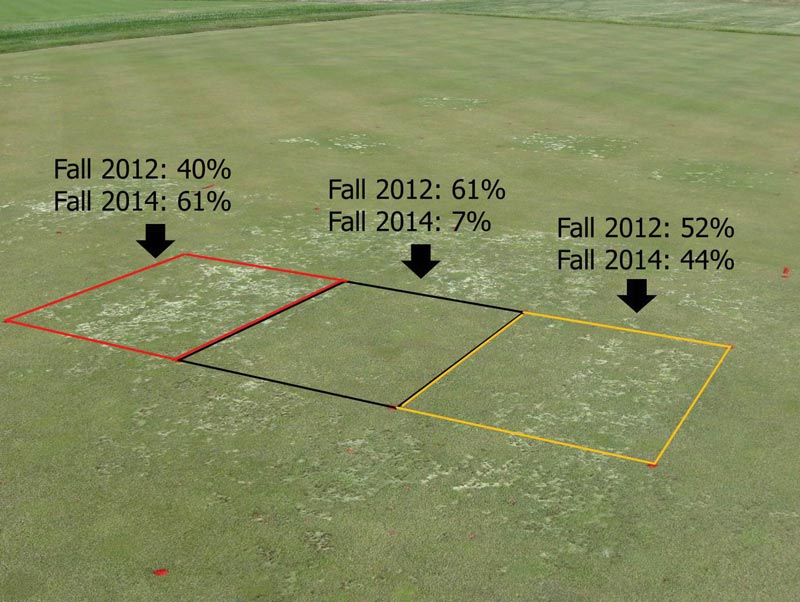
Figure 3. Change in silvery-thread moss cover from the beginning of the study in fall 2012 until its completion in fall 2014. Red = untreated, black = hollow-tine aerification + carfentrazone, and yellow = hollow-tine aerification only. Percentages indicate the level of silvery-thread moss infestation.
Our research demonstrates that hollow-tine aerification or vertislicing in tandem with split applications of carfentrazone effectively accomplishes these goals. Unfortunately, cultivation disrupts playability. Therefore, we recommend selectively implementing cultivation in those areas where silvery-thread moss is most prevalent if twice yearly cultivation is not feasible. Greatest reductions in silvery-thread moss cover will likely be attained by combining cultivation and carfentrazone (Figure 3, above), but further research is needed to determine the optimal timing and frequency.
Although light, frequent topdressing did not reduce silvery-thread moss cover in our study, other research supports its inclusion as part of a comprehensive silvery-thread moss management strategy. A light, frequent topdressing program should help reduce survival of dispersed fragments and bulbils by burying the propagules. Lastly, this research may be most applicable to putting greens with severe (for example, >10%) silvery-thread moss infestations. It is unclear if very small infestations (for example, 1% or less) would respond to cultivation in the same manner. Investigating such a scenario could be the subject of future research.
Acknowledgments
We thank the Kansas Turfgrass Foundation for funding this research.
The research says ...
- The objective of this research was to determine whether aerification or vertislicing alone or in combination with topdressing or herbicide application could successfully control silvery-thread moss in putting greens.
- Both aerification and vertislicing reduced silvery-thread moss cover compared with the untreated control by the end of the study.
- The herbicide carfentrazone provided the greatest moss control, but it did not eradicate it.
- Light, frequent topdressing had no effect on moss cover, but it enhanced turf color and quality.
Literature cited
- Borst, S.M., J.S. McElroy and G.K. Breeden. 2010. Silvery-thread moss control in creeping bentgrass putting greens with mancozeb plus copper hydroxide and carfentrazone applied in conjunction with cultural practices. HortTechnology 20(3):574-578.
- Crum, H.A., and L.E. Anderson. 1981. Mosses of Eastern North America, 2 Vols. Columbia University Press, New York.
- Horsley, K., L.R. Stark and N.D. McLetchie. 2011. Does the silver moss Bryum argenteum exhibit sex-specific patterns in vegetative growth rate, asexual fitness or prezygotic reproductive investment? Annals of Botany 107:897-907.
- Kennelly, M.M, T.C. Todd, D.M. Settle and J.D. Fry. 2010. Moss control on creeping bentgrass greens with standard and alternative approaches. HortScience 45(4):654-659.
- Longton, R.E. 1981. Inter-population variation in morphology and physiology in the cosmopolitan moss Bryum argenteum Hedw. Journal of Bryology 11:501-520.
- Lyons, E.M, K.S. Jordan, I.T. James, D.M. Hudner and D. McGowan. 2012. Irrigation frequency influences the establishment of silvery thread moss (Bryum argenteum Hedw.) and rooting of creeping bentgrass (Agrostis stolonifera L.) on simulated golf greens. Acta Agriculturae Scandinavica, Section B: Soil & Plant Science (Supplement 1) 62:79-85.
- Post, A.R., D.S. McCall and S.D. Askew. 2016. Preemergence control of silvery thread moss (Bryum argenteum) grown from spores and bulbils in axenic culture. Weed Technology 30(1):198-206.
- Raudenbush, Z. 2015. Cultural and chemical control of silvery-thread moss in creeping bentgrass putting greens. Ph.D. dissertation. Kansas State University, Manhattan, Kan.
- Raudenbush, Z., and S.J. Keeley. 2014. Springtime dandelion (Taraxacum officinale) control with seven postemergence herbicides applied at three anthesis stages. HortScience 49(9):1212-1216.
- Raudenbush, Z., and S.J. Keeley. 2015. Effect of nitrogen source and spray volume on the establishment and colonization of silvery-thread moss (Bryum argenteum Hedw.) in putting greens. Crop, Forage & Turfgrass Management doi:10.2134/cftm2105.0140
- Raudenbush, Z., S.J. Keeley and L.R. Stark. 2015. A review: establishment, dispersal, and management of silvery-thread moss (Bryum argenteum Hedw.) in putting greens. Crop, Forage & Turfgrass Management doi:10.2134/cftm2014.0094
- Reicher, Z., and D. Weisenberger. 2007. Herbicide selection and application timing in the fall affects control of ground ivy. Online. Applied Turfgrass Science doi:10.1094/ATS-2007-0831-01-RS
- Selkirk, P.M., M.L. Skotnicki, J.A. Ninham, M.B. Connett and J. Armstrong. 1998. Genetic variation and dispersal of Bryum argenteum and Hennediella meimii populations in the Garwood Valley, Southern Victoria Land, Antarctica. Antarctic Science 10:423-430.
- Senseman, S.A. 2007. Herbicide Handbook. 9th edition. Weed Science Society of America, Lawrence, Kan. Pages 197-199.
- Thompson, C., J.D. Fry and M.M. Kennelly. 2011a. Evaluation of conventional and alternative products for silvery-thread moss control in creeping bentgrass. Online. Applied Turfgrass Science doi:10.1094/ATS-2011-1018-01-RS
- Thompson, C., M.M. Kennelly and J.D. Fry. 2011b. Effect of nitrogen source on silvery-thread moss on a creeping bentgrass putting green. Online. Applied Turfgrass Science doi:10.1094/ATS-2011-1018-02-RS
Zane Raudenbush is an assistant professor at the Ohio State University Agricultural Technical Institute, Wooster, Ohio, and Steven J. Keeley is a professor at Kansas State University, Manhattan, Kan.